

New AI Development So Advanced It's Too Dangerous To Release, Says Scientists. A group of scientists at OpenAI, a nonprofit research company supported by Elon Musk, has raised some red flags by developing an advanced AI they say is too dangerous to be released.
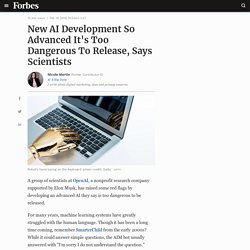
For many years, machine learning systems have greatly struggled with the human language. Though it has been a long time coming, remember SmarterChild from the early 2000s? While it could answer simple questions, the AIM bot usually answered with "I'm sorry I do not understand the question. " However, with new methods in analyzing texts, AI has the ability to now answer like a human with little indication that it is a program. The machine learning computer model, called GPT2, generates synthetic text based on written prompts ranging from single words to full pages.
In one example, the researchers prompted their algorithm with a fictional news article about scientists who discovered unicorns. The first part of the nine-paragraph article from the algorithm reads: Human prompt: "Recycling is good for the world. Google Code of Conduct - Investor Relations - Alphabet. 02.02.2021 Alphabet Announces Fourth Quarter and Fiscal Year 2020 Results more 01.28.2021 2020 10-K/Earnings Release Announcements more 01.21.2021 Alphabet to Present at the Goldman Sachs 2021 Technology and Internet Conference more 01.13.2021 Alphabet Announces Date of Fourth Quarter 2020 Financial Results Conference Call more 11.25.2020 Alphabet to Present at the UBS Global TMT Virtual Conference more 11.09.2020 Alphabet to Present at the RBC Capital Markets 2020 Technology, Internet, Media and Telecommunications Conference more 10.29.2020 Alphabet Announces Third Quarter 2020 Results more See previous press releases here.
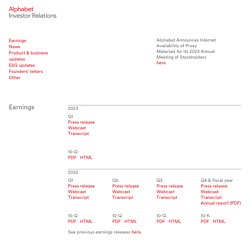
Cultural Differences in Moral Reasoning. ...
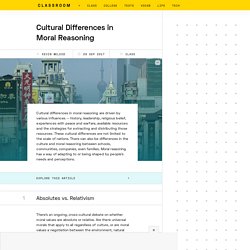
Goodshoot/Goodshoot/Getty Images Cultural differences in moral reasoning are driven by various influences -- history, leadership, religious belief, experiences with peace and warfare, available resources and the strategies for extracting and distributing those resources. These cultural differences are not limited to the scale of nations. There can also be differences in the culture and moral reasoning between schools, communities, companies, even families. Moral reasoning has a way of adapting to or being shaped by people's needs and perceptions.
Good AI, Bad AI - Psychological Aspects of a Dual-Use Technology. This Discussion is important for Humanity AI is a dual-use technology that can be used for both civilian and military purposes or alternatively with good or bad intentionsTech giants are in a precarious position where their technology is being used more and more for military purposes, against the values of users and employeesResponsibility grows on all sides, behavioral alternatives become more and more complexAnxiety and feeling overwhelmed lead to lethargy and paralysis within the affected people and make communication and motivation for action more difficultCommunication about AI and its implications must be moved away from threats and fear mongering, to facts, visions and clear reasons why The publicized cases of the Hololens or Project Maven, show impressively on what thin ice tech companies are moving, especially those giants who are in the limelight, such as Microsoft or Google.
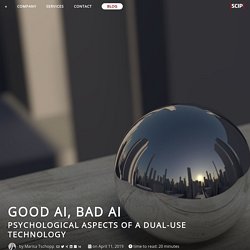
Unfortunately, there is no such thing as a patent solution for dealing with AI properly. Thoughts on AI from a Psychological Perspective: Defining Intelligence. First of all, although it may be obvious to some, it’s important to note that Artificial Intelligence (deep learning especially) is a mechanized, simplified version of human neural networks and cognitive processing.

Text - H.R.2231 - 116th Congress (2019-2020): Algorithmic Accountability Act of 2019. Moral Algorithms. Thus spake HAL 9000 in Stanley Kubrick’s 1968 masterpiece 2001: A Space Odyssey.

The computer saw Dave’s request as jeopardizing the mission and acted accordingly. HAL’s algorithms were moral. Not to be outdone by science fiction, Congress last year introduced something called the Algorithmic Accountability Act, a novel attempt to hold computer programs accountable for immoral behavior. Artificial Intelligence. Artificial intelligence (AI), sometimes known as machine intelligence, refers to the ability of computers to perform human-like feats of cognition including learning, problem-solving, perception, decision-making, and speech and language.

Early AI systems had the ability to defeat a world chess champion, map streets, and compose music. Thanks to more advanced algorithms, data volumes, and computer power and storage, AI evolved and expanded to include more sophisticated applications, such as self-driving cars, improved fraud detection, and “personal assistants” like Siri and Alexa. IT & Etik. Elon Musk: 90 procents risk att AI utplånar mänskligheten - IDG.se. Domedagsprofeten Elon Musk har gång efter annan pekat ut artificiell intelligens som ett av de största hoten mot mänskligheten.

Nick Bostrom: Superintelligens kan komma att förändra hela världen. Om stridens psykologi – Del 8: Autonoma vapensystem: Drönare, distribuerat dödande & obehagens dal – KUNGL KRIGSVETENSKAPSAKADEMIEN. Hur kommer det sig att vi utvecklar empati med vissa människoliknande robotar men känner rädsla och avsky för andra?
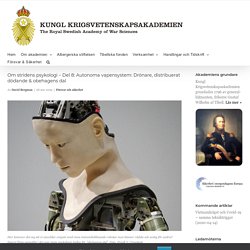
Ska få robotar att passa in. Redan i dag finns robotar på sjukhus, skolor, affärer och i våra hem.

Men för att robotar ska fungera optimalt i samspel med människor måste de kunna anpassa sig till förändringar i miljön. Datavetaren Tomasz Kucner har tagit fram en datadriven modell, som gör att robotar lättare kan smälta in i olika miljöer. De flesta robotar i dag fungerar på följande sätt: de tar in information, planerar och utför sedan sin uppgift. Robotdiskussioner. E halsa valfardsteknik etik sammanstallning 2017. När får robotar mänskliga rättigheter? Under Almedalsveckan förra året var det någon som twittrade; "Alla pratar digitalisering i Almedalen förutom partiledarna". Under årets Almedalsvecka skulle man kunna återanvända den slutsatsen, med tillägget ”automatisering och artificiell intelligens”.
För det var detta - och innovation - som alla pratade om i Almedalen 2017. Det var nog sista året som man satte ordet digitalt framför allting, nästa år är det underförstått. Då kan vi gå tillbaka till att prata om nya arbetssätt, nya affärsmodeller och nya värden utan att blanda in på vilket sett de levereras. Min roll är att hjälpa våra kunder med den förändring som digitaliseringen innebär. Hur man leder i förändring (strategier är bara fantasier för att minska sin oro)integritetsfrågan med all data vi har om konsumenterna (vem läser avtalen man godkänner?) Det fanns nog inget perspektiv som inte diskuterades i Almedalen. Så, välkommen till framtiden, en framtid där vi inte pratar digitalisering utan vad det betyder att vara människa. AI: Det här är artificiell intelligens AI och så funkar det. Här är AI-bolagen som investerarna älskar. Sedan 2011 har det investerats runt 198 miljoner dollar i tekniktunga svenska techbolag, ett område där bland annat artificiell intelligens ingår.
Artificial Intelligence: Friend or Foe? AI Experiments. Etik och moral - viktig aspekt för framtidens AI - Pressrum. How Digital Technology Is Creating a World of Introverts. Just take a good look around and soak up the changing social atmosphere. One person has their nose pressed against the text screen, stumbles— and continues walking; someone else is posting a “selfie” up on Instagram from their tablet; and a third just opened their laptop to see if that girl ever messaged him back on OkCupid. Gone are the days of playing “kick the can” with the neighborhood kids. Scratch that idea altogether; we now have LAN parties and order pizza online. Need a date? Researchers Taught an AI About Ownership Rules and Social Norms. “No Baxter, That’s Mine!” What is yours is not mine, and what is mine is not yours — unless we agree to share it. This simple example of how we agree on ownership of objects around us is something that may come naturally to us, but it’s a notion that robotic systems have to be taught first — in much the same way a child is taught about what belongs to them, and what doesn’t.
And a group of researchers at Yale University tried to do just that. They successfully taught a robotic system about ownership relations and the social norms that determine those relations — a much overlooked, but critical aspect of human-machine interaction. And the results are promising: in a series of simulations, the robot could infer which objects belonged to it, and which didn’t — even with a “limited amount of training data,” according to a pre-written paper. Peaceful Coexistence “I’m Afraid I Can’t Do That” Nu blir robotarna sociala. På Kungliga Tekniska högskolan i Stockholm försöker forskare att få robotar att bli mer sociala på mänskligt vis. Tre etiska utmaningar för att lyckas med AI.
AI innebär stora förändringar för hur människor använder tekniklösningar. Företag måste fastställa etiska riktlinjer för hur AI ska användas, vilket gäller även tillverkande företag. Lundaforskare om riskerna med artificiell intelligens. New AI Development So Advanced It's Too Dangerous To Release, Says Scientists. Human Cognition and Artificial Intelligence - A Plea for Science. Cognition comprises mental process of the human brainArtificial Intelligence tries to mimic these processes to solve complex problems and handle massive amounts of dataSerial vs. parallel and controlled vs. automated processes are the basis of cognitive sciencesLogic, probability theory and heuristics represent the pillars of theory formation for the human-machine comparisonArtificial neural networks (mimicking the human brain) are popular, because great advancements in specific fields were achievedSystemic problem solving is still visionary, but a number of research projects are promisingReciprocal, positive influences across disciplines might lead to rapid transformationPolemics, as well idealism are out of placeAnalysis must adhere to scientific and ethical standards with long-term orientation for the public goodAfter the physiological review, the next chapter will focus on consciousness (as a part of what gives life to physiology) Overview of Cognitive Psychology.
Hacking Artificial Intelligence – Influencing and Cases of Manipulation. How to hack an AI Artificial intelligence is playing an ever greater role in our societyInterest in hacking this technology is therefore on the riseHackers can cause trouble by manipulating input, processing, technology stacks and learning mechanismsThe traditional methods of defensive hardware and software development are also essential when implementing secure AI The discussion presented here applies to both strong and weak AI applications in equal measure. In both cases, input is collected and processed before an appropriate response is produced. It doesn’t matter whether the system is designed for classic image recognition, a voice assistant on a smartphone, or a fully automated combat robot.
The goal is the same: to interfere with the intended process. Image recognition might be tricked into returning incorrect results; illogical dialogs might be prompted with a voice assistant; or the fundamental behaviors of a combat robot might be deliberately overridden. About the Author. Artificial Intelligence - Is it worth the risk? Is Artificial Intelligence worth the Risk The Titanium Trust Report is a mixed methods analysis with 111 participants from heterogeneous backgrounds and expertise to investigate trust and artificial intelligenceThe qualitative section explores fear and skepticism towards artificial intelligence14 sub-categories were identified, like fear of robots or AI in healthcareAI in warfare, loss of control, and privacy and security are the most mentioned categoriesDespite the dangers, the majority of participants believe AI is worth the riskImplications include education and awareness on the individual level, regulation policies on the macro level, and focus on security and performance on the technical level Trust can be seen as a psychological mechanism to cope with uncertainty and is located somewhere between the known and the unknown (Botsman, 2017).
On the individual level, trust is deeply ingrained in our personality. AI & Trust - Stop asking how to increase trust in AI. This is how we trust technology This report offers a theoretical background on trust, outcomes of a workshop on trust and personal reflections of the authorConfusion about terminologies (trust, reliance, trustworthiness) is prevailing and impedes progressTrustworthiness as a property is distinct from but related to trust as an attitudeInterpersonal trust can be partially translated to trust in automation and AITrust is critical because it mediates reliance on automation and AIUsers must be skeptical and find the right level of trust to use technology properly avoiding under- or overrelianceTechnology providers must earn user trust through demonstrating trustworthiness At the NZZ Future Health Conference in Basel, we had the opportunity to put years of theoretical research into practice.
With over 30 participants we held a workshop, working on a mutual understanding of trust in artificial intelligence, what it means, what it does, how to deal with it. References Botsman, R. (2020). Links. Psychology of Artificial Intelligence - Foundations, Range, Implications from a humanities perspective. Massive rise of AI research and other channelsAI research inevitably requires an interdisciplinary approachPsychology and AI are inseparableAI strikes humanity where it hurts: vulnerability, replacementFurther series will include: brain, conscience, behavior, ethics, practice In Michael Ende’s fantasy novel The Never Ending Story a troubled boy starts reading in a somewhat dark and scary and yet exciting book about a beautiful place threatened by the so called Nothing. Not knowing if he is just observing or an actual part of this adventure the boy decides to go on, dive into the adventurous undertaking and (spoiler alert!)
In the end – saves the world. Do We Need Asimov’s Laws? In 1942, the science fiction author Isaac Asimov published a short story called Runaround in which he introduced three laws that governed the behaviour of robots. The three laws are as follows: 1. A robot may not injure a human being or, through inaction, allow a human being to come to harm. 2. A robot must obey the orders given to it by human beings, except where such orders would conflict with the First Law. 3.
These charts will change how you see the rise of AI. Etisk Artificiell Intelligens - Utveckling av transparens. How music recommendation works — and doesn’t work – □ variogram by Brian Whitman. How AI helps Spotify win in the music streaming world - Outside Insight. Where AI Is Headed: 13 Artificial Intelligence Predictions for 2018.
Cultural Differences in Moral Reasoning. How artificial intelligence will affect your life and work in 2018. 2018 ai predictions.